10 BASIC GUIDELINES FOR DESIGNING SCREEN PRINTING ARTWORK
Screen printing artwork is a popular and versatile printing technique used to create vibrant and durable prints on various surfaces. When it comes to designing artwork for screen printing, certain guidelines should be followed to ensure optimal results. In this article, we will discuss ten printing guidelines for graphic designers and artists to consider when creating basic screen printing artwork. Whether you are a beginner or an experienced designer, these guidelines will help you create stunning and successful screen printed designs.
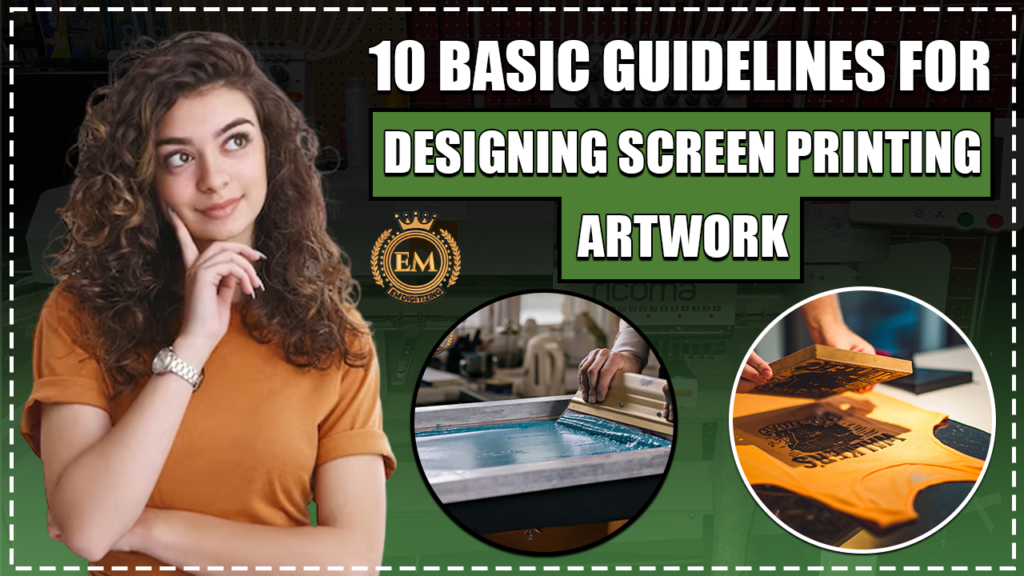
10 BASIC GUIDELINES FOR DESIGNING SCREEN PRINTING ARTWORK
10 Basic Guidelines For Designing For Screen Printing
Let’s discuss 10 basic guidelines for screen printing artwork:
Keep it Simple and Clear
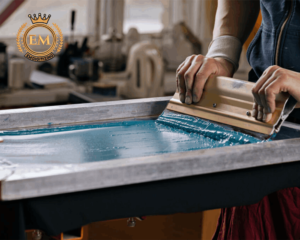
One of the fundamental principles of screen printing artwork is to keep the design simple and clear. Since screen printing involves layering ink colors one on top of another, intricate details and fine lines may not translate well onto the final print. It is best to create bold and easily recognizable designs with clear shapes and solid colors. Avoid intricate patterns or very small text, as they may become blurred or lost during the printing process.
Use High Contrast Colors
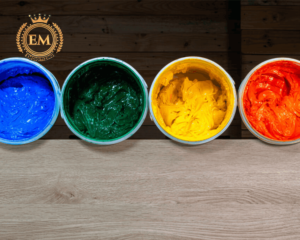
To achieve visually striking screen prints, it is essential to use high contrast colors. Select colors that complement each other and create a noticeable distinction between different elements of your design. High contrast helps to enhance the visibility and legibility of the artwork, making it more impactful.
Create Vector-based Artwork

Vector-based artwork is ideal for screen printing as it allows for scalability without loss of quality. When creating your design, use vector graphics software such as Adobe Illustrator to ensure that your artwork can be easily resized and adjusted to fit various printing sizes without compromising clarity.
Use Spot Colors

Basic printing utilizes spot colors, which are pre-mixed ink colors applied individually to the printing surface. When designing for screen printing, it is crucial to use spot colors rather than relying on digital color modes. Spot colors offer a more accurate representation of the intended color, resulting in consistent and vibrant prints.
Pay Attention to Ink Coverage
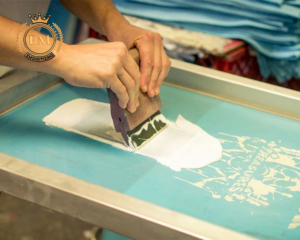
Consider the amount of ink coverage required for your design. Excessive ink coverage can lead to bleeding, smudging, or a loss of fine details. On the other hand, insufficient ink coverage may result in a patchy or uneven print. Strike a balance between the amount of ink used and the desired effect to achieve optimal results.
Mind the Screen Printing Constraints
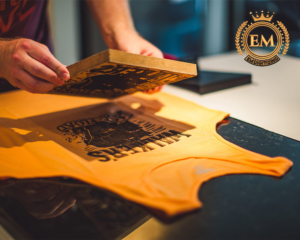
Understanding the technical limitations of screen printing is crucial when designing artwork. Keep in mind that each color in your embroidery design requires a separate screen, so a design with too many colors can become complex and costly. Limit your color palette to a reasonable number of colors to maintain simplicity and efficiency in the printing process.
Test for Halftones and Gradients
If your design includes gradients or halftones, it is essential to test how they will appear when translated into screen printing. These effects can be achieved through the use of halftone screens or by manually creating halftone dots. Testing will help ensure that the desired gradient or shading effect is achieved in the final print.
Consider the Printing Substrate
Different printing substrates may require specific considerations when designing for screen printing. Whether it’s fabric, paper, or other materials, be mindful of the surface texture and characteristics. Adjust your design accordingly to ensure optimal adhesion and compatibility between the ink and the substrate.
Provide Clear and Accurate Artwork Files
When submitting your artwork to a screen printing service, ensure that you provide clear and accurate files. Use the appropriate file formats such as vector files (AI, EPS, or PDF) and include any necessary instructions or color references. Clear communication with the printer will help ensure that your design is reproduced accurately.
Seek Professional Advice and Collaboration
If you are new to screen printing or have a complex project, it is wise to seek professional advice and collaborate with experienced screen printers. They can provide valuable insights, suggest improvements, and help troubleshoot potential issues. Collaboration can enhance the quality of your screen printed artwork and ensure a successful outcome.
These were the 10 basic guidelines for designing screen print artwork. Let’s share some more guidelines to help you understand even better:
Understand Screen Mesh and Resolution
The screen mesh used in screen printing plays a crucial role in determining the level of detail and resolution in your artwork. Higher mesh counts allow for finer details, while lower mesh counts are better suited for bold and larger elements. Consider the level of detail in your design and choose an appropriate screen mesh to achieve the desired result.
Optimize Artwork for Screen Printing Techniques
Screen printing offers various techniques, such as discharge printing, water-based printing, or specialty inks. Familiarize yourself with these techniques and tailor your artwork accordingly. Certain designs or effects may work better with specific screen printing methods, resulting in unique and eye-catching prints.
Create Mockups and Proofs
Before proceeding with the final printing, it is advisable to create mockups and proofs to visualize how your artwork will appear on the intended printing substrate. This step allows for adjustments and ensures that your design is accurately represented in the final print.
Consider Placement and Sizing
When designing artwork for screen printing, consider the placement and sizing on the printing surface. Take into account the dimensions and proportions of the substrate to ensure that your design fits appropriately and looks visually balanced.
Incorporate Textures and Overprints
Experiment with textures and overprints to add depth and visual interest to your screen printed artwork. Incorporating subtle textures or layering different ink colors can create unique and captivating effects, elevating the overall impact of your design.
Don’t Forget about Registration Marks
Including registration marks in your artwork is essential for accurate alignment and registration of colors during the printing process. These marks help ensure that each color layer aligns correctly, resulting in a crisp and well-defined print.
Test Different Ink and Substrate Combinations
Screen printing offers versatility in terms of ink types and printing substrates. Take the time to test different ink and substrate combinations to understand how they interact and influence the final outcome. This experimentation can lead to innovative and unexpected results.
Strive for Originality and Creativity
In a saturated market, originality and creativity are key to standing out. Push the boundaries of screen printing by exploring unique concepts, incorporating unconventional elements, or experimenting with unconventional color schemes. Let your artistic vision shine through and create prints that captivate and inspire.
Embrace Feedback and Iteration
Screen printing is a collaborative process, and feedback from both clients and print professionals is invaluable. Embrace constructive criticism, iterate on your designs, and strive for continuous improvement. This iterative approach will help refine your screen printing artwork and elevate your skills as a designer.
Stay Updated on Industry Trends and Techniques
The world of screen printing is constantly evolving, with new trends, techniques, and technologies emerging. Stay informed about the latest developments in the industry, attend workshops or conferences, and engage with the screen printing community. This continuous learning process will keep your designs fresh and relevant.
By following these additional guidelines, you can further enhance your screen printing artwork. Remember, screen printing is both an art and a science, so embrace experimentation, learn from experience, and enjoy the process of creating captivating and visually stunning prints.
Conclusion:
Designing artwork for screen printing requires careful consideration of various factors, from simplicity and color contrast to technical constraints and file formats. By following these ten basic guidelines, you can create visually appealing and successful screen printed designs. Remember, each step, from concept to print, plays a significant role in achieving the desired result. So, embrace the creative possibilities of screen printing and let your designs design screen print come to life through this timeless and versatile printing technique.
If you want to customize embroidery logo digitizing, EM DIGITIZING will be your best choice. At EM DIGITIZING, we deliver the best embroidery logo digitizing services with the best quality. We offer 50% off on all our services to our potential customers on their first order. So, get a free quote now and we will get in touch with you.
Hope this article will be helpful for you guys!
If there’s any question related to this article feel free to comment to us. And, thanks for reading!
Screen printing artwork refers to the specific design or image that is prepared and used for the screen printing process. It is typically created digitally or hand-drawn and then transferred onto a screen to be printed onto various surfaces.
To make screen prints of art, you first need to create a stencil or screen with the desired artwork. The stencil is then placed onto the screen, ink is applied, and the ink is pressed through the screen onto the desired surface using a squeegee. This process can be repeated to create multiple prints of the artwork.
For screen printing, it is best to provide vector-based artwork files such as AI (Adobe Illustrator), EPS (Encapsulated PostScript), or PDF (Portable Document Format). These file formats maintain the scalability and quality of the artwork, ensuring precise reproduction during the screen printing process.
A screen print can be considered an original art form if the design or artwork being printed is unique and created specifically for the screen printing process. Each print produced using the screen is considered an original piece, even though multiple prints can be made from the same screen.
To transfer a design to a screen print, the design is typically prepared digitally or hand-drawn, then transferred onto a screen using a light-sensitive emulsion or stencil. The screen is then placed on top of the printing surface, and ink is forced through the screen using a squeegee, transferring the design onto the surface.
